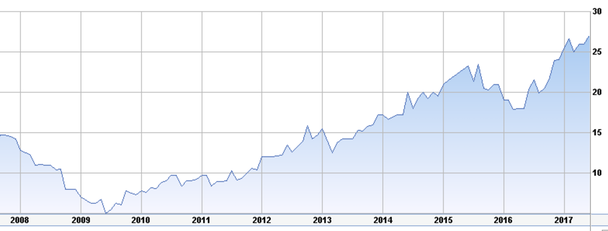 In August 2016, I published an article entitled “To GAAP or NON-GAAP, That Is The Question” that discussed how we here at Geo Investing like to approach the topic of GAAP vs. adjusted earnings. Our team spends every morning reading earnings press releases and adjusting them for non-operational line items to get a better picture of how a company’s books really fair. Consider it removing the jargon and noise to actually see what is going on.
In August 2016, I published an article entitled “To GAAP or NON-GAAP, That Is The Question” that discussed how we here at Geo Investing like to approach the topic of GAAP vs. adjusted earnings. Our team spends every morning reading earnings press releases and adjusting them for non-operational line items to get a better picture of how a company’s books really fair. Consider it removing the jargon and noise to actually see what is going on.
During my OTC research session, I came across a shareholder letter written by the CEO of Mestek Inc. (PINK:MCCK), Stewart Reed. I found his discussion on GAAP vs. non-GAAP refreshing. In the aftermath of blow ups like Valeant Pharmaceuticals (NYSE:VRX) and Endo International (NMS:ENDP), it’s great to come across a microcap company CEO who is keeping it real and creating wealth for shareholders in a sustainable, common sense manner.
MCCK 10 Yr. Chart

Mestek Inc. Shareholder Letter Addresses GAAP
Here is the letter in its entirety where Mr. Reed references Jeff Bezos of Amazon.com Inc. (NMS:AMZN) and Warren Buffett.
FIRST QUARTER REPORT | TO SHAREHOLDERS | For the quarter ended March 31, 2017 | 260 North Elm Street, Westfield, MA 01085 | (413) 568-568-9571 www.mestek.com
May 2017
Fellow Shareholders,
GAAP accounting is useful, necessary, and a sincere attempt to portray financial reality. Still, no universal standard such as GAAP can properly present the individual nuances of a given business. Yet, GAAP is an important and somewhat accurate measure mitigating the self-serving explanations of business leaders trying to pump alternative measures of progress and their stock prices. GAAP is a good baseline to consider as a first pass to valuation. “Next year’s projected operating earnings”, Wall Street’s favorite measure, ignores past mistakes (management of course will never make any future mistakes), botched acquisitions, so-called “one-off” costs that should be forgotten and forgiven by investors, “restructuring costs” that somehow have a nasty habit of reoccurring, and other Wall Street sell-side euphemisms.
Sometimes GAAP understates the value of an enterprise; Amazon is a good example. As long as the company’s internet retail operations continue to grow at a brisk pace, Amazon is a cash generating machine. And playing the long game both in retail and web services is likely to be richly rewarded eventually. Jeff Bezos has correctly noted that acorns can grow into mighty oak trees. Alternatively, many public companies try to maximize reported earnings by pressing the limits of GAAP; FIFO rather than LIFO inventory accounting, failure to address slow moving and obsolete inventories, capitalizing every allowable operating cost, inadequate reserves, and other creative ways designed by clever CFO’s holding stock options. Sometimes it’s not clever accountants; it’s inherent in the business model. For example, Warren Buffet noted that BNSF Railway substantially understates depreciation costs because necessary equipment replacements now cost substantially more than the equipment being replaced.
For Mestek, GAAP is a fair measure. Our accounting is conservative within the confines of GAAP and tax regulations; and business model nuances result in both pluses and minuses tending to neutralize each other. I believe gross profit is overstated by adherence to GAAP; for example manufacturers’ representative sales commissions are a variable cost which should be above the gross profit line, and is put there in our internal accounting. Still, the operating profit line is accurate, if you disregard the other items line which is almost all platinum trading activities. First quarter 2017 platinum trading was $1 million positive versus $2 million positive for Q1 2016. By making this one adjustment, you will see that true operating profits were flat, nearly identical to last year. You can additionally note that without the platinum gains, after-tax operating profits would be eight cents per share lower for Q1 2017. This is not alarming; January through June is always weak compared to the July through December period due to normal seasonal sales variations in our comfort heating products. Heating equipment consisting of commercial boilers, residential and commercial baseboard, unit heaters and rooftop make-up air units, and industrial comfort heating equipment are important drivers of revenues and earnings.
First quarter sales increased modestly, 4% in HVAC and architectural and 7% in machinery. Pay no attention to the increase in selling expense since it is mostly third party commissions which logically should be deducted above the gross profit line. The $400,000 increase in engineering expense is a real comparable cost difference as we continue to step up new product development activities. Margins are being somewhat squeezed by higher raw material costs; including steel, copper, and aluminum increases. This margin squeeze will probably continue until we realize price increases to offset the higher costs, an uneven process.
No balance sheet or cash flow issues are of particular note, other than the payment of annual bonuses in March (approximately $4.7 million), and taking delivery of CME platinum warrants (approximately $4.1 million) rather than rolling forward futures contracts. Mestek regularly engages in spread transactions to minimize carrying costs and earn the equivalent of interest on its platinum holdings.
At March 31, the HVAC backlog was flat with last year; and the machinery backlog was modestly higher. Currently the HVAC backlog is 8% higher than last year; and the machinery backlog is 6% higher. We continue to quote opportunities at a relatively brisk pace; but some projects have been put on hold for various reasons we are not privy to.
Mestek management remains grateful to our shareholder owners for your patience and support, thank you; and we pledge to work diligently to improve the intrinsic value of your company.
With kind regards,
Stewart B. Reed
Chairman & CEO
GAAP Creates Fair Comparisons
After reading this CEO’s letter, you have a really good understanding of what is going on with his company, both the numbers that are reflected in the financials and the “why” that contributed to them. GAAP cannot readily capture the “why” but does create a way to fairly compare the numbers assuming no accounting shenanigans. The clarity that Mr. Reed gives is welcome, and creates greater belief in the operations and leadership of an organization that adheres to these principles. We can see this belief reflected in the stock chart above. We at Geo Investing wish more executives would follow this tact as it in the end creates more real wealth for shareholders. Imagine that, accounting honesty actually being the best policy.